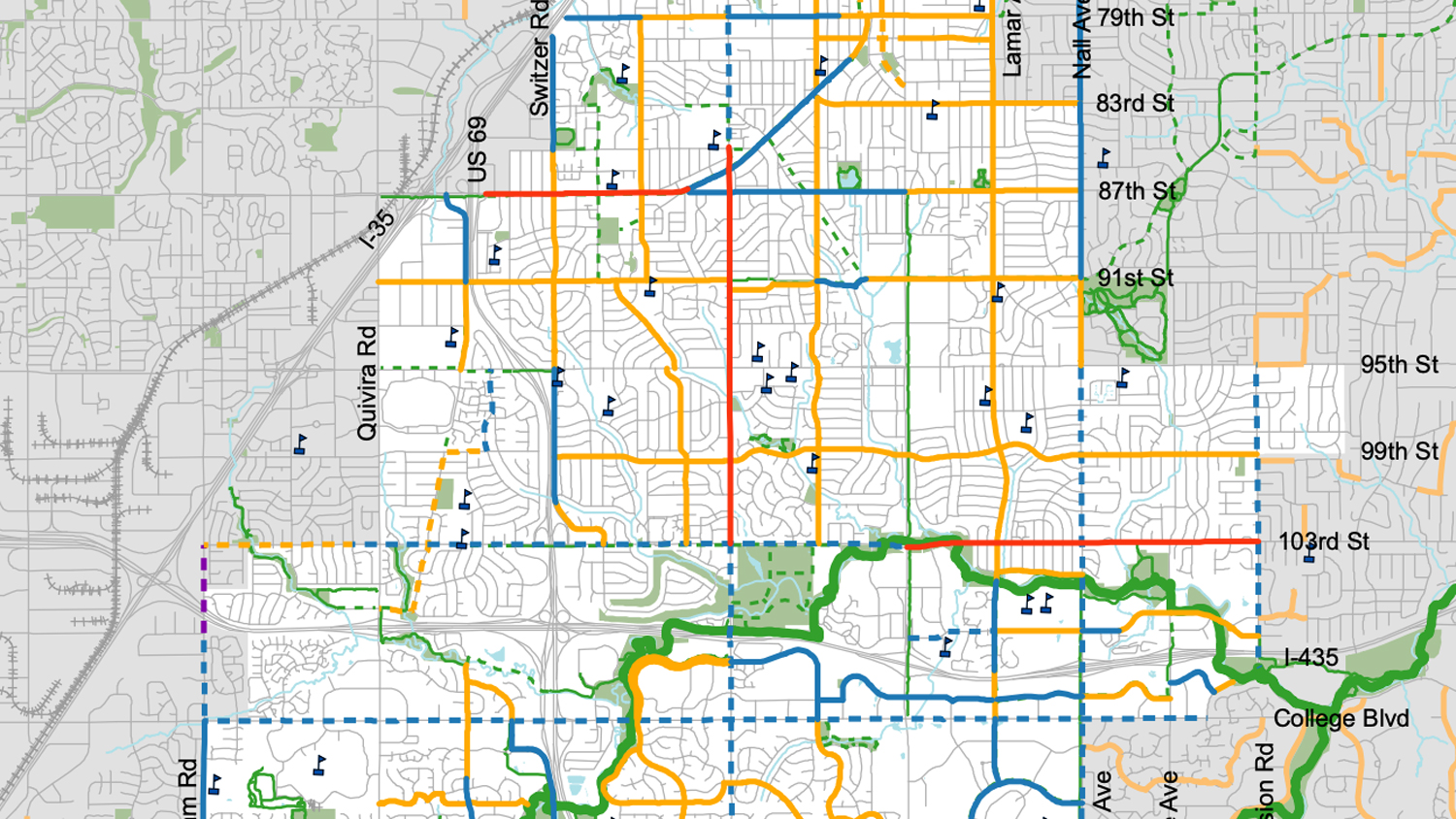
If you’re thinking about ditching your car or truck, even if it’s just for a dinner out or to run an errand, there are options to traveling Overland Park without a vehicle. Skip the gas station and read below to plan your next car-less trip:
Public Transportation
Eight RideKC routes serve Overland Park. The 403, one of the most popular routes in Overland Park, begins running during the 5 a.m. hour and doesn’t stop until after 7 p.m. Residents can ride from Johnson County Community College to 75th Street in just over 20 minutes.
This is in addition to the Johnson County Micro Transit system, an affordable ride-hailing transportation option. You’ll share a van with others going the same direction, and while it’s technically still a vehicle, you’ll be doing your part to reduce cars on the road. In addition to serving a large part of Overland Park Monday-Saturday, 6 a.m.-8 p.m., Micro Transit runs on Saturdays to and from the Farmers’ Market thanks to an interlocal agreement between the City and RideKC.
On Two Wheels
Overland Park currently has 163 miles of bicycle infrastructure, including 61 miles of dedicated bike lanes and 67 miles of sharrows. Residents can choose several different streets to ride from the City’s northern boundary at 47th Street, all the way to approximately 203rd Street, and to many destinations east-to-west along the way. Most routes include dedicated bike lanes, and many include sharrows.
The City of Overland Park is currently working to implement its Bicycle Master Plan, which proposes 263 miles of bicycling infrastructure citywide. As streets are improved and reconstructed, traffic engineers are constantly looking for opportunities to add additional bicycling infrastructure.
Check out the Bike Lane Map to see everywhere you can go on two wheels.
On Foot
The City has more than 800 miles of sidewalks, on thoroughfares and neighborhood streets.
Developers are required to build sidewalks when constructing new homes, which allows pedestrians access to amenities and neighborhoods as well. Sidewalks are also added when streets are rebuilt through the neighborhood street reconstruction program.
Recently redeveloped areas of the city encourage pedestrian traffic within specific districts, including Downtown Overland Park and Prairiefire. In Downtown Overland Park, density, streetscapes and sidewalks promote walkability.
Bike/Hike Trails
If you’re not running an errand or trying to get to a class, consider a walk, jog or ride on the extensive bike/hike trail system. Hop on at more than a dozen trailheads and enjoy a relatively level, flat and wide paved trail open to non-motorized traffic only. You can even connect to nearby cities’ bike/hike trails and take the system all the way into Kansas City, Mo.
Get Involved
Comprehensive Plan
The City is preparing for the 2022 Comprehensive Plan review right now.
The review will gauge the desires of the community, evaluate existing and emerging issues in the City and align the Comprehensive Plan with Forward OP, the City’s community vision. The review will include extensive public engagement and and focus on implementation steps.
You can prepare to be involved in next year’s review now, by checking out our speaker series. September’s speaker will address transportation issues for consideration. The 2022 review will address transportation, including options for non-vehicular traffic.
Merriam Drive Corridor Study
Together with the cities of Merriam, Overland Park, Mission, and Kansas City, Kan., the City is studying transportation modes along and around Merriam Drive in northern Overland Park, including vehicular traffic, bicycle and pedestrian infrastructure, and public transit.
There’s still time to get involved on this study as well. Visit the project page to learn more.
OP Central
You can get involved in helping a central part of the city become a friendlier place for non-drivers. The City is currently studying non-vehicular transportation options in the OPCentral district, and we need your feedback.
Visit the OP Central page to take the survey and help us gauge mobility options that have worked in other cities. You can learn more about upcoming public meetings online as well.
College Boulevard went on a “road diet” in 2020 to provide more options for pedestrians and cyclists to move about that area. This was an early step in implementing a plan to improve walkability and attractions in this area.
More Options to Come
Additional items already under consideration or in implementation phases that promote multimodal transportation in Overland Park include:
- Trail improvements, including along 91st Street, which will join Cherokee Park with Meadowbrook Park in Prairie Village;
- Thoroughfare improvements that include bike lanes (Switzer Rd., 159th to 167th Streets and 167th, Switzer to Antioch) and multiuse paths, which allow for bikes and pedestrians to share a wider sidewalk area without having to get out in the street;
- Construction of roundabouts, which are safer for all users and provide a greener and more pleasant traveling experience because vehicles are not idling at traffic signals;
- An e-bike pilot program that considers the use of e-bikes on City trails;
- A motorized scooter pilot program that is likely to begin next year;
- Conversion of remaining streetlights to LEDs, which provide better lighting conditions for pedestrians and cyclists to see and be seen, and more.
